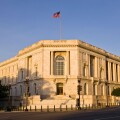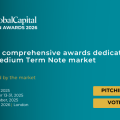Top section
Top section
◆ Relative value against covereds is important ◆ Spread 'could have been pushed more' ◆ Lack of SSA supply a factor
Next year's programme will be similar in size and strategy to 2025's, but adds something new
More articles/Bonc comments/Ad
More articles/Bonc comments/Ad
More articles
-
First EGB syndication and first dollar SSA bond after tariff mayhem put investor demand to test
-
◆ Quick intra-day trade was ‘right thing to do’ ◆ Tough decision on the starting level ◆ Smaller issuers’ spread to larger peers key to pricing
-
When it seems as if it is only short-term survival that matters, the best bankers don’t lose sight of the distant horizon
-
There are growing signs of a global reluctance to embrace environmental, social and governance (ESG) principles, with talk of greenhushing emerging in many pockets of the bond market. Yet, Japan’s top regulatory bodies and issuers are eager to embrace ESG and, in particular, to continue growing their transition bond market, seeing its potential for ushering in change and reaching net-zero commitments.
-
Japan’s sovereign, supranational and agency borrowers are among the most well regarded and highly rated in the international debt markets. Yet they are not immune to the volatility caused by the new US administration under president Donald Trump or the pressure from contrasting monetary policies implemented by different central banks. Timing deals well, being nimble and having diverse sources of funding are all expected to be critical in the year ahead.
-
Public sector funding options less sure after swap spread gyrations and hit to confidence in US
Sub-sections
-
Sponsored by CAF – Development Bank of Latin America and the Caribbean
CAF gearing up to transform regional development
-
Sponsored by European Investment Bank
European Investment Bank: Supporting sustainable development in North Africa
-
-
Comment



























